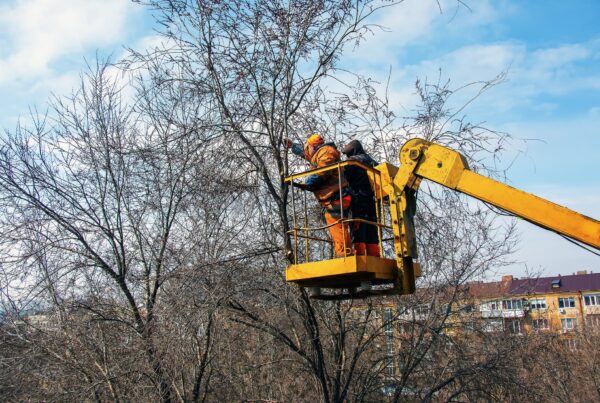Winter poses unique challenges to tree health in Menomonee Falls. As a homeowner committed to maintaining a beautiful and valuable property, learning the essentials of winter tree care is crucial. This guide, grounded in RG Tree’s extensive 50-year history and local expertise, offers practical advice on how to support your trees during the colder months.
Understanding Tree Stress During Winter
Trees in Menomonee Falls face a host of stressors during the winter months. Common factors contributing to tree stress include cold snaps and fluctuating temperatures, which can lead to structural damage or disrupt natural dormancy. These temperature changes are especially harsh since they can cause freeze-thaw cycles, disrupting water flow within tree tissues.
Snow cover presents a dual challenge by both insulating and affecting soil moisture retention. While snow can protect roots by providing a natural blanket, it may also trap moisture in the soil leading to overly saturated conditions as it melts. This can wreak havoc on root health if left unmanaged.
Vigilance for signs of stress is key. Watch for symptoms such as cracking bark, browning of leaves or needles, and premature leaf drop. By recognizing these signs, homeowners can take timely action to mitigate damage and maintain tree health.
In addition, ensuring proper maintenance practices such as mulching and checking for root exposure is crucial during winter months. Proactive care helps safeguard your trees against harsher environmental conditions.
Essential Winter Tree Maintenance Practices
Preparing your trees before the first frost can make a significant difference in their winter survival. Starting with proper pruning, you can enhance a tree’s ability to withstand winter stress. Careful pruning removes dead or weak branches, reducing the risk of breakage under snow or ice loads.
Here are some recommended pruning tools:
- Hand pruners for small branches
- Loppers for medium-sized branches
- Pruning saws for larger limbs
- Pole pruners to reach higher branches
In addition to pruning, managing snow loads is essential. Gently removing accumulated snow can prevent branch breakage; however, be careful not to shake branches excessively as this may cause more harm than good.
Finally, mulching around the base of your trees can provide insulation and help retain soil moisture. A layer of organic mulch around the root zone will help maintain a stable environment for the roots beneath the snow. Applying mulch in late fall also helps protect roots from freezing and thawing cycles, offering resilience against winter’s challenges.
Protecting Your Trees from Winter Damage
Protecting your trees from the harsh winter conditions in Menomonee Falls requires several proactive steps. Sensitive trees may benefit from windbreaks or barriers that shield them from strong, desiccating winds.
Using anti-desiccant sprays can be beneficial to prevent moisture loss through evaporation, particularly for evergreens, which continue to face moisture demands even during dormancy.
Pest management is also crucial, as some insects remain active or lay eggs during winter months. Regular inspections can help manage any pest threat before it becomes severe.
Young trees, in particular, require additional protection from wildlife, such as deer or rabbits, that might seek out bark as a food source when other resources are scarce. Simple steps, such as using tree guards or wraps, can provide the necessary protection.
Furthermore, wrapping tree trunks with burlap or using wire cages can prevent trunk damage caused by frost cracks or animal activity, ensuring that young trees safely endure the colder months.
Leveraging RG Tree’s Expertise
RG Tree’s local expertise is invaluable when it comes to providing effective winter tree care strategies that are tailored to the unique environment of Menomonee Falls. With over 50 years of experience, RG Tree offers professional insights that ensure comprehensive care tailored to your property’s specific needs.
Considering whether to handle tree care yourself or hire a professional? Below is a comparison to help you decide:
| Aspect | DIY Tree Care | Professional Tree Care | Additional Services |
|---|---|---|---|
| Time Requirement | High, typically requires weekends or free time | Minimal, scheduled services handle all tasks | Emergency winter storm recovery |
| Expertise Level | Varies, dependent on personal knowledge | Expert, backed by experience and professional training | Detailed health assessments and recommendations |
| Risk of Damage | Higher if done incorrectly | Lower, professionals ensure safe techniques | Guaranteed safety and enhanced aesthetics |
| Cost | Potentially lower but risks increased costs from mistakes | Higher, but offers peace of mind and quality | Included in seasonal contracts |
RG Tree provides seasonal service offers specifically tailored to Menomonee Falls homeowners, ensuring your trees get the expert attention they need without breaking the bank. With countless testimonials and positive feedback, RG Tree’s commitment to exceptional service speaks for itself, giving homeowners the confidence they need in their tree care provider.
Frequently Asked Questions
What are some common winter stress factors for trees in Menomonee Falls?
Common stress factors include cold snaps and fluctuating temperatures that cause freeze-thaw cycles, snow cover that affects soil moisture retention, and other environmental conditions like stress from excessive cold or water flow disruption in tree tissues.
How can homeowners manage tree stress during winter?
Homeowners can manage tree stress by monitoring for signs of stress like cracking bark or premature leaf drop, using proper maintenance practices such as mulching, and checking for root exposure.
What are the essential winter tree maintenance practices to follow?
Essential practices include pruning dead or weak branches, managing snow loads on branches, and applying mulch around the base of trees to insulate and retain soil moisture.
How can snow loads affect trees and what can be done to mitigate their impact?
Snow loads can cause branches to break under the weight. Homeowners can gently remove accumulated snow, but should avoid shaking branches excessively to prevent damage.
Why is mulching around trees beneficial during winter?
Mulching provides insulation, helps retain soil moisture, and protects roots from freeze-thaw cycles, maintaining a stable environment for tree roots.
What measures can be taken to protect trees from harsh winter winds?
Sensitive trees can benefit from windbreaks or barriers that shield them from strong winds, reducing moisture loss through evaporation, especially for evergreens.
What role does pest management play in winter tree care?
Pest management is important because some insects can remain active or lay eggs during winter months, necessitating regular inspections to manage potential threats.
How can young trees be protected from wildlife during winter?
Young trees can be safeguarded from wildlife like deer or rabbits by using tree guards, wraps, or burlap to prevent animals from feeding on the bark.
What are the benefits of choosing professional tree care services over DIY?
Professional services offer expertise, reduce risk of damage, and save time, despite being more costly. Professionals provide detailed assessments and recommendations, ensuring safe and effective tree care.



